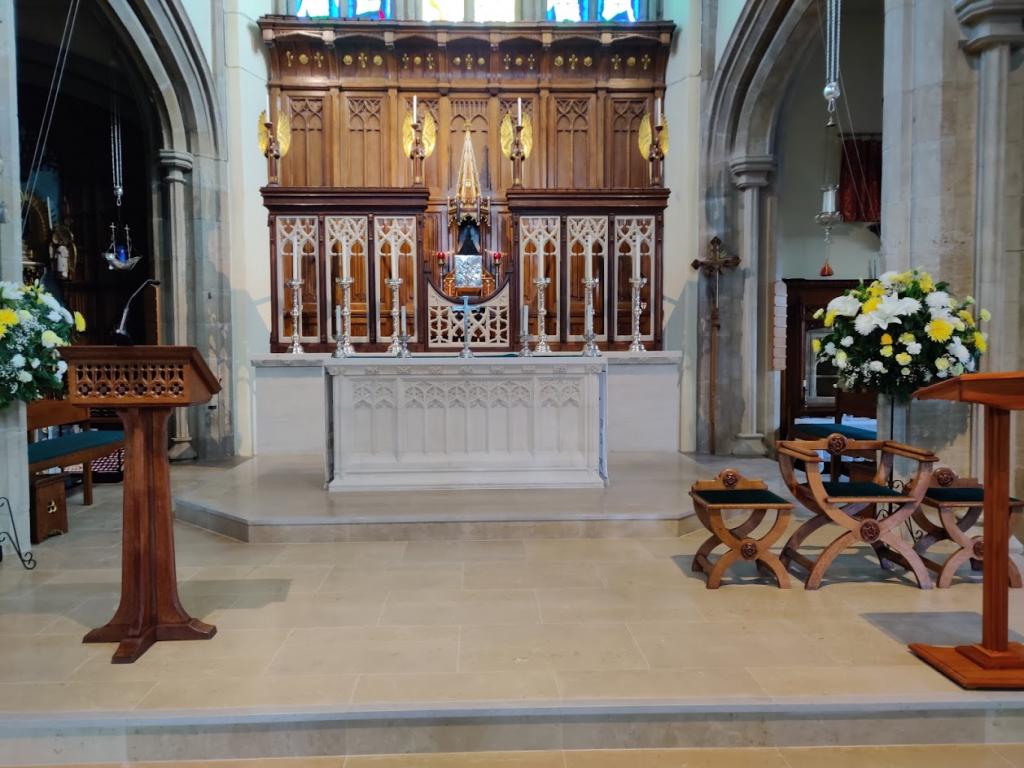On Sunday 19th January 2020, Cardinal Vincent celebrated Mass at the RC Church of St George, Sudbury, and presided at the dedication ceremony for the church’s new altar and sanctuary. After the Litany of the Saints, the dedication ceremony began with the depositing of the relics of four saints in the aperture in the altar: Pope St Clement I, Pope St Urban I, Pope St Pontian and St John Southworth. The aperture was then closed by a stonemason. The rite of placing relics beneath an altar signifies that all who have been baptised in the death of Christ share in Christ’s passion.
The Cardinal then offerred a special prayer of dedication, a sign of the intention to dedicate the altar to the Lord for all times and a petition for his blessing. Following the prayer of dedication, the Cardinal performed the rites of anointing, incensing, covering, and lighting the altar. Anointing the altar with oil makes the altar a symbol of Christ. The burning of incense is a sign that Christ’s sacrifice ascends to God as an odour of sweetness. The covering of the altar indicates that the Christian altar is the altar of the Eucharistic sacrifice and the table of the Lord. The lighting of the altar teaches us that Christ is ‘a light to enlighten the nations’.
St George’s was built in 1928 for a small Catholic community as the suburbs in north London developed. Fr Clement Russell remained Parish Priest from its building until the mid-1960s and imposed his particular character and style upon the parish that lasted many years.
By the late twentieth century, the parish congregation had outgrown the building. Between 1989 and 1994 the parish embarked on a major re-ordering scheme which initially included the extension of the church westwards towards the Harrow Road. Such a project proved too expensive; instead, the side chapels and sacristy were removed and redeveloped in order to provide additional seating. It was at this point that the sanctuary was also re-ordered. Almost all the original furnishings and statues were removed. At the behest of English heritage, some of the oak panelling was preserved. St George’s was listed as a Grade II building in 1994, primarily in order to prevent further alterations. A novel interpretation of the norms given in the General Instruction of the Roman Missal for church appointments concluded in a ‘linear sanctuary’ with claims to fourth century models.
In the last decade, the parish has seen a swift and increasing demographic change with the congregation becoming representative of the new Catholic communities from Sri-Lanka, India and Poland. Today, the Mass count is around 1,600 to 1,700 on an average Sunday, with five Sunday Masses celebrated. There are two full-time diocesan priests and a full-time catechetical co-ordinator. The parish has a well-supported, two-class-entry primary school.
Given the practical challenges posed by the linear design and small hexagonal altar, the parish recently decided to revisit the preservation project. A plan for a new sanctuary, drawn up by the architectural firm of Colin Smart, was scrutinised and approved by the Historic Churches Commission. The parish was offered the stone and altar from the R H Benson chapel at Hare Street House, which has now been remodelled for the new sanctuary. The donated altar is a more appropriate size for the liturgies. The project involved the widening and shortening of the current sanctuary, creating a generous space for weddings and funerals to take place. Particular importance was given to the placement of the four major features: tabernacle, altar, lectern and chair as well as the spatial element of the sanctuary. Chairs and a lectern have been placed in front of the altar, and a screen has been placed before the steps to the Blessed Sacrament, creating a ‘chapel’ behind the altar.




